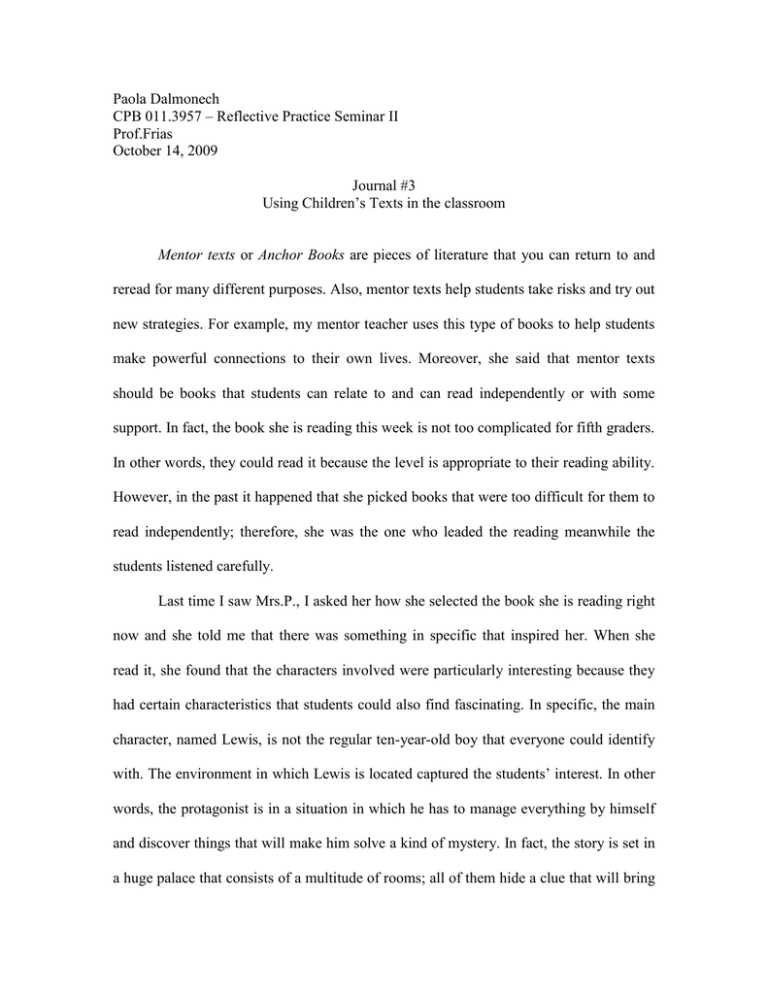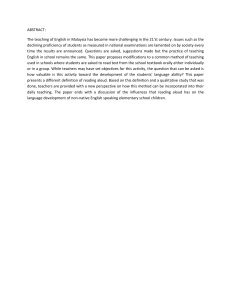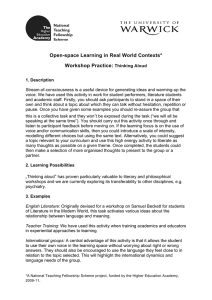Paola Dalmonech CPB 011.3957 – Reflective Practice Seminar II Prof.Frias October 14, 2009
advertisement

Paola Dalmonech CPB 011.3957 – Reflective Practice Seminar II Prof.Frias October 14, 2009 Journal #3 Using Children’s Texts in the classroom Mentor texts or Anchor Books are pieces of literature that you can return to and reread for many different purposes. Also, mentor texts help students take risks and try out new strategies. For example, my mentor teacher uses this type of books to help students make powerful connections to their own lives. Moreover, she said that mentor texts should be books that students can relate to and can read independently or with some support. In fact, the book she is reading this week is not too complicated for fifth graders. In other words, they could read it because the level is appropriate to their reading ability. However, in the past it happened that she picked books that were too difficult for them to read independently; therefore, she was the one who leaded the reading meanwhile the students listened carefully. Last time I saw Mrs.P., I asked her how she selected the book she is reading right now and she told me that there was something in specific that inspired her. When she read it, she found that the characters involved were particularly interesting because they had certain characteristics that students could also find fascinating. In specific, the main character, named Lewis, is not the regular ten-year-old boy that everyone could identify with. The environment in which Lewis is located captured the students’ interest. In other words, the protagonist is in a situation in which he has to manage everything by himself and discover things that will make him solve a kind of mystery. In fact, the story is set in a huge palace that consists of a multitude of rooms; all of them hide a clue that will bring him to the solution of the enigma. Thus, I now understand that Mrs.P. selects the books to read in class according to the message they convey. A couple of days ago, I was in my internship class and I had the chance to attend one of the reading aloud activities, and it was very interesting to see how the students were actively involved. The teacher had introduced the book several days before; therefore, that morning, the reading was going to continue from the point they stopped the day before. The teacher asked one student to turn off the light because that represents the start of the reading aloud. The atmosphere of the classroom immediately changed. The students were sitting on the colorful carpet and in front of them was the teacher sitting on the rocky chair. During the reading aloud, Mrs.P. was putting a lot of emphasis that undoubtedly caught the students’ attention. She was pronouncing the words very clearly using a tone of voice that made the students become more and more involved; moreover, punctuation helped her to read beautifully. I think this is very important because a well-structured reading aloud implies that the teacher uses fluency and expressivity. To read effectively, you have to act and be able to make voices, so then students can identify themselves with the characters of the story. I strongly believe that Mrs.P.’s reading performance resulted to be very efficient because she was capable of drawing her students into it. Although she had introduced the book previously, the first thing she did as soon as the period started was a retelling of the chapter recently read. She called out one student and asked to summarize the last few pages by giving the highlights of what was more important to remember. She formulated questions such as “Tell me in your own words what happened in the last chapter we read” or “Describe the last scene that we read”. By doing so, everyone in the class reinforced their knowledge and refreshed their memory. Hence, the teacher began to read the new section of the book. From time to time, she would stop to think through what was being read as the passage was read aloud. In this way, the teacher made the students think critically and report out what their thinking was. She gave them a question to think aloud and used the turn and talk to your partner strategy in which each pair discusses the question that was asked, and eventually shared it within a class conversation. The question could be “What do you think about the idea of…?” or “What is the relationship between the two characters of the story? Do you find similarities or contrasts?” Everybody is allowed to respond because participation is very significant, yet they have to raise their hands and wait to be called by the teacher. At the end of the activity, the teacher stopped the reading with a phrase that enhanced the students’ curiosity. Thus, she assigned them to predict what the next scene would look like and what would happen to the characters; that is called making a prediction. She emphasized the fact that their prediction should be said by starting with sentences such as, “I am guessing that ____ will happen next”, “I bet that ____” or “I wonder if ____”. Everything she did in class was planned ahead. Teacher’s preparation for the reading aloud activity consists of: - highlighting places to stop, to question, to make predictions, or to make connections; - making discussion questions before the lesson; - practicing reading the selection using gesture and voice intonation, as I explained above; - finally, planning before, during, and after reading activities definitely helps to enhance the comprehension. Overall, I think that the picture book Mrs.P. chose provided the models that helped and will help students to grow as readers in the future. She was able to stimulate their creativity and create more interest. Most importantly, the think aloud strategy helped students to understand that reading should make sense, and to move beyond literal decoding to comprehending. I think it also helped them to learn, think, and reflect upon themselves and the reading they usually do individually. When the teacher models, students listen and observe carefully, so then when it’s their turn, they remember and are able to imitate correctly. Reading aloud always implies a purpose. In the case of Mrs.P., the purpose was first to perform the think aloud strategy used to model summarizing. In fact, students were asked to recapitulate what occurred in the previous scene. Secondly, the teacher used the making prediction strategy where students had to predict what could happen in the next passage. This activity was well organized because students responded accurately using the proper language that suited the activity.


